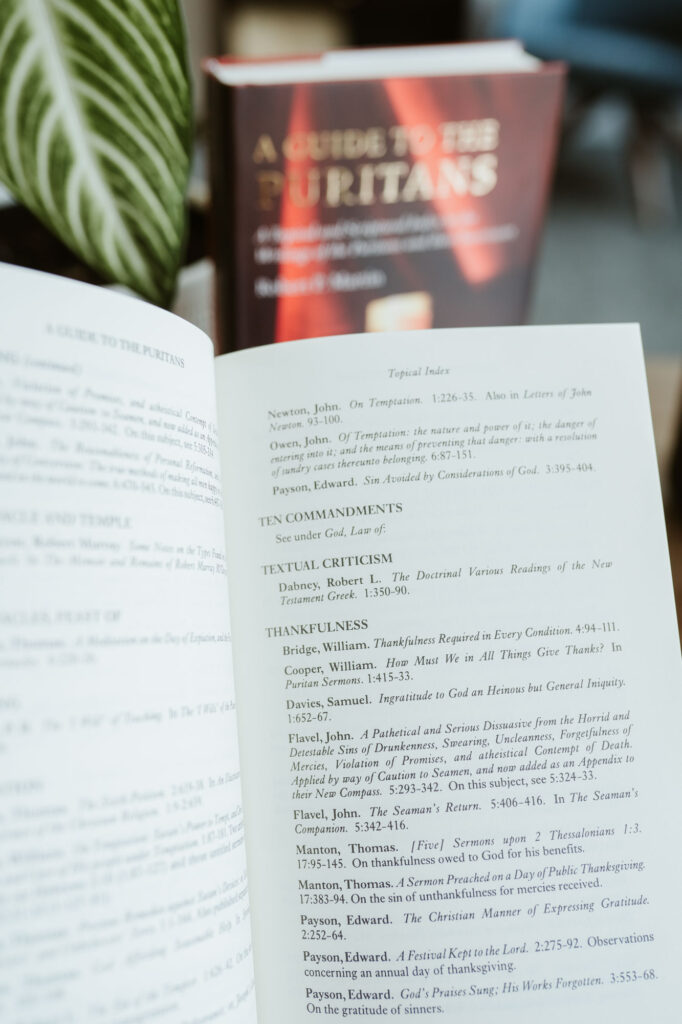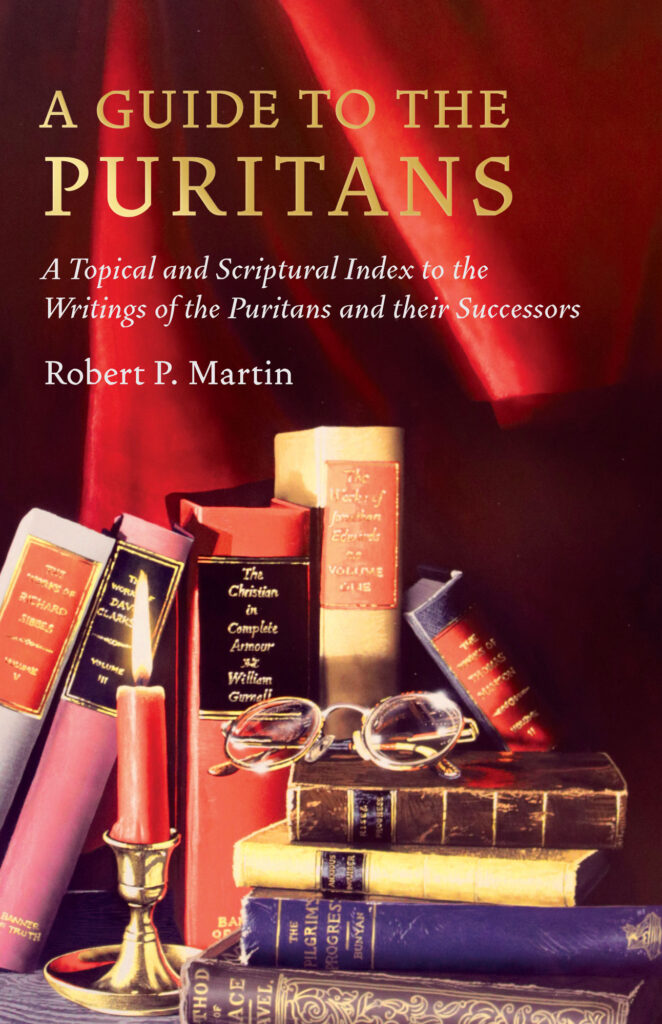A Guide to the Puritans: A Topical and Scriptural Index to the Writings of the Puritans and their Successors is the fruit of a monumental task undertaken by the late Dr. Robert P. Martin. As the subtitle states, this volume is an index to the writings of the Puritans and those who “have looked to the Puritans as their nearest theological kin.”1 Comprehensive in its scope, A Guide to the Puritans includes a topical index, a Scripture index, biographical sketches of the authors, and indices of miscellaneous writings such as funeral sermons, ordination sermons, letters, and more. The final section of the book includes a bibliography of the works indexed.
The physical book itself is exactly what you would expect from Banner of Truth: quality, Smyth-sewn binding, beautiful cloth-bound cover, and thick, cream paper with almost no ghosting. This volume will last for generations.


About the Author
Dr. Robert P. Martin (1948–2016) was a graduate of Southwestern Theological Seminary in Fort Worth, Texas where he earned a Master of Divinity degree and a PhD in New Testament studies. He served as Dean and Professor at Trinity Ministerial Academy in New Jersey and pastored Trinity Baptist Church. In 1995, his family relocated to Seattle, Washington to accept the call to pastor Emmanuel Baptist Church in SeaTac, where he pastored for nineteen years. He wrote several books, and continued teaching in various seminaries in the U.S. and Internationally. Not long before his death in 2016, he completed a commentary on Hebrews.
Though he was a very educated man, Dr. Martin didn’t feel entirely qualified to compile such a volume, but he did so because he believed the rich heritage of the Puritans’ writings should be accessible to God’s people. He wrote in the preface,
“Such a rich heritage should be accessible; however, for many, finding one’s way around a banquet table is a frustrating experience. This is especially true for ministers wanting to digest strong Puritan meat in order to serve it to their people . . . This volume, therefore, is the product of my frustrations; and my hope is that it will help God’s people and God’s servants mine the rich vein of Puritan gold available today in printed form.”2
Dr. Martin may not have been the most qualified to undertake this massive project, but he was willing—and his labor has benefited thousands of readers, including myself.
The title of the book is a little bit of a misnomer, but the subtitle is quite clarifying; rather than using “Puritan” in a narrow sense—referring only to those who desired reformation in the national church of England during the sixteenth and seventeenth centuries—he applies it in a broader sense:
“I am using the term Puritan in the broader religious sense of those advocating the experimental, calvinistic religion which the Puritans exemplified. Moreover, I have cast my net even farther to take in those who have looked to the Puritans as their nearest theological kin; thus including such men as Archibald Alexander, Charles Hodge, B. B. Warfield, W. G. T. Shedd, John Murray, and many other modern Puritans.”3
Topical Index
The topical index is ordered alphabetically, beginning with the topics of “Abortion,” “Abraham,” “Access to God,” “Accountability,” etc. Each topic heading is then followed by a list of writings which correspond to the topic, sorted alphabetically by author. For example, the topic of “Adoption” includes the following entries:
- Boston, Thomas. Adoption. 1:612–42. In An Illustration of the Doctrines of the Christian Religion. 1:9–2:659.
- Boston, Thomas. Of the Benefits Flowing from Justification, Adoption, and Sanctification. 2:15–27. In An Illustration of the Doctrines of the Christian Religion. 1:9–2:659.
- Boston, Thomas. The Divine Call to Leave the Devil’s Family, Explained and Urged. 1:643–53. In An Illustration of the Doctrines of the Christian Religion. 1:9–2:659.
- Drake, Roger. The Believer’s Dignity and Duty Laid Open, in the High Birth wherewith he is Privileged, and the Honourable Employment to which he is Called. In Puritans Sermons. 5:328–44.
- Ferguson, Sinclair B. Children of the Living God. 127 pages.
- Girardeau, John L. Discussions of Theological Questions. On this subject, see pages 428–521.
- Murray, John. Adoption. In Collected Writings, 2:223–34.
- Webb, Robert Alexander. The Reformed Doctrine of Adoption. 188 pages.
As you can see, there is a mix of Puritan and modern authors listed, providing a fairly comprehensive index of writings that span multiple centuries.
Topics which have subtopics are nested and organized in the same fashion. For example, “Christ” has many writings listed within the topic, then breaks into subtopics such “Christ—Advocate,” “Christ—Apostle,” “Christ—Ascension of,” etc.
If a particular topic can logically be called by another name, they are grouped together under one heading. For example, the topic “Schism” says, “See under Divisions.”
Scripture Index
The Scripture index is laid out in the same way as the topical index, but is sorted according to the order of the books of the Bible. For example, the first four entries for Acts appear as follows:
ACTS
- 1:9–11 Payson, Edward. Christ’s Ascension. 3:115–23.
- 1:13 Ryle, J. C. They Went Up Into An Upper Room. In The Upper Room. 11–24.
- 2:16–17 Warfield, Benjamin B. The Outpouring of the Spirit. In Faith and Life. 135–45.
- 2:23 Flavel, John. The Nature and Quality of Christ’s Death. 1:320–32. In The Fountain of Life. 1:17–561.
Miscellaneous
Following the topical and Scriptural indices is a collection of miscellaneous sermons, letters, and other writings on various topics such as funerals, ordinations, and other special occasions. The entries are all organized in the same way the topical and Scriptural indices are.
Bibliography of Works Indexed
Where it all ties together is the “Bibliography of Works Indexed,” located at the very back of the book. If you have any of the aforementioned works above, you might simply fetch the book from your bookcase and begin reading in the pages mentioned. However, if you do not own it, the bibliography (sorted alphabetically by author) will provide you with the publisher of the work, so you can know exactly which edition to look for.
Weaknesses
Naturally, a printed index like A Guide to the Puritans runs the risk of becoming outdated fairly quickly—especially when the types of works indexed in it are highly sought after. Since it first came off the press in 1997, many Puritan works have been reprinted or republished by various publishers, and are obviously not included in the book. Even in 1997, Dr. Martin was aware of the volume’s shortcomings. He wrote,
“I will not be surprised if those who use this volume find many things which could be done better, especially in the topical index. My hope, however, is that those find flaws will favor me with their suggestions for improvement, so that if future editions come from the press, the people of God will be served better than at present.”4
Unfortunately, Dr. Martin died in 2016, and no revisions were ever made to the book. Banner of Truth released a beautiful, cloth-bound edition of the book in 2023, but the text was simply a reprint of the first edition and included no revisions or updates. However, the book is still an incredibly valuable resource many years after its publication, and I am certain it will continue to serve thousands of readers for years to come.
Conclusion
The value of this incredible book far outweighs any weaknesses it may have. If you enjoy reading the Puritans or would like to learn more about them, this book is a necessity. The writings of the Puritans can sometimes seem like an unscalable mountain. The collected works of John Owen alone constitute 23 volumes—and that’s the old facsimile edition! A Guide to the Puritans is exactly that—a knowledgeable guide who will show you exactly where to begin climbing the mountain and help you mine the rich treasures buried beneath it.
Footnotes
- Robert P. Martin, A Guide to the Puritans: A Topical and Scriptural Index to the Writings of the Puritans and their Successors (Edinburgh: Banner of Truth, 1997), x.
- Ibid., ix.
- Ibid., x.
- Ibid., x.


